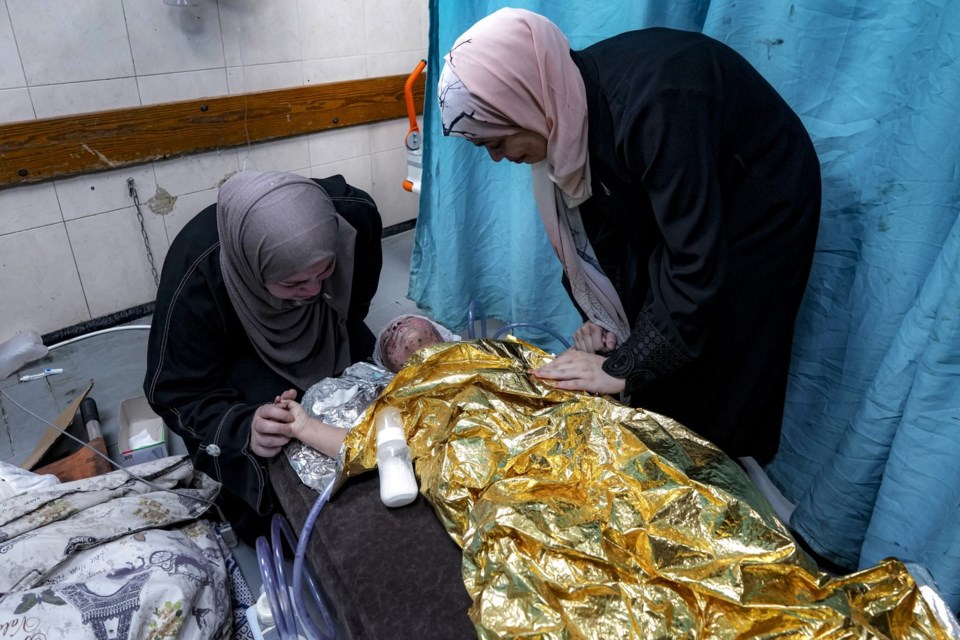DEIR AL-BALAH, Gaza Strip (AP) — Israeli airstrikes hit a school being used by displaced people in central Gaza on Saturday, killing dozens, as the country’s negotiators prepared to meet international mediators to discuss a proposed cease-fire.
At least 30 people sheltering at a girls' school in Deir Al-Balah were taken to Al Aqsa Hospital and pronounced dead after a strike that Israel's military said targeted a Hamas command and control center used to store weapons and plan attacks. It said militants “used the compound as a hiding place to direct and plan numerous attacks against IDF troops” and “developed and stored large quantities of weapons inside.”
Civil defense workers in Gaza said that thousands were sheltering in the school, which also contained a medical site.
Near the hospital, where the bodies were transported, Associated Press journalists saw an ambulance rushing through a dusty road as a few people ran in the opposite direction. An injured man lay on a stretcher on the ground. A body covered with a blanket and a dead toddler lay inside the ambulance.
Inside the school, classrooms were in ruins. People were seen searching for victims under the rubble and some were gathering the remains of those who were killed.
Gaza’s Health Ministry said at least 12 people had been killed in other strikes on Saturday.
The strikes hit a day before officials from the U.S., Egypt, Qatar and Israel are scheduled to meet in Italy to discuss the ongoing hostage and cease-fire negotiations. CIA Director Bill Burns is expected to meet Qatari Prime Minister Mohammed Bin Abdul Rahman al-Thani, Mossad director David Barnea and Egyptian spy chief Abbas Kamel on Sunday, according to officials from the U.S. and Egypt who spoke on condition of anonymity as they were not authorized to discuss the plans.
U.S. officials said on Friday that Israel and Hamas are in agreement on the basic framework of the three-phase deal under consideration. However, in Israeli Prime Minister Benjamin Netanyahu's speech to the U.S. Congress, he vowed to press forward with the war until Israel achieves “total victory.”
Palestinian officials vehemently condemned the speech after the school strike. Nabil Abu Rudeineh, spokesperson for Palestinian Authority President Mahmoud Abbas, said in a statement that Netanyahu's reception from his supporters in the United States constituted a “green light” to continue Israel's offensive.
“Every time the occupation bombs a school that shelters displaced persons, we see only some condemnations and denunciations that will not force the occupation to stop its bloody aggression,” he said.
Humanitarian zone evacuated ahead of strikes
Earlier, Israel's military ordered the evacuation of a part of a designated humanitarian zone in Gaza ahead of a planned strike on Khan Younis on Saturday.
The evacuation order was in response to rocket fire that Israel said originated from the area. The military said it planned an operation against Hamas militants in the city, including parts of Muwasi, the crowded tent camp in an area where Israel has told thousands of Palestinians to seek refuge throughout the war.
It’s the second evacuation order issued in a week that has included striking part of the humanitarian zone, a 60-square-kilometer (roughly 20-square-mile) blanketed with tent camps that lack sanitation and medical facilities and have limited access to aid, United Nations and humanitarian groups say. Israel expanded the zone in May to take in people fleeing Rafah, where more than half of Gaza’s population at the time had crowded.
Gaza Health Ministry officials said the evacuation orders had forced at least three health centers to stop providing care and compounded existing issues such as displaced people crammed in places where waste has piled up and hygiene kits are unavailable.
According to Israeli estimates, about 1.8 million Palestinians are currently sheltering there after being uprooted multiple times in search of safety during Israel’s punishing air and ground campaign. In November, the military said the area could still be struck and that it was “not a safe zone, but it is a safer place than any other” in Gaza.
The U.N. agency for Palestinian refugees, known as UNRWA, said it was increasingly difficult to know how many people would be affected by the evacuation order because those sheltering under there were constantly being displaced.
“Referring to the orders as evacuation orders don’t do any justice to what this means,” said Juliette Touma, the agency's director of communications. “These are forced displacement orders. What happens is when people have these orders, they have very little time to move.”
Further north, Palestinians mourned the deaths of seven killed by Israeli airstrikes overnight on Zawaida, in central Gaza. Members of two families — parents and their two children as well as a mother and her two children — were wrapped in traditional Islamic white burial shrouds as community members gathered to perform funeral rights. As men lined up to pray in front of the bodies, weeping friends and neighbors approached individually to pay their final respects.
Deir al-Balah’s Al Aqsa Hospital confirmed the count and Associated Press journalists saw the bodies.
The war in Gaza has killed more than 39,200 Palestinians, according to the territory’s Health Ministry, which doesn’t distinguish between combatants and civilians in its count. The U.N. estimated in February that some 17,000 children in the territory are now unaccompanied, and the number is likely to have grown since.
The war began with an assault by Hamas militants on southern Israel on Oct. 7 that killed 1,200 people, most of them civilians, and took about 250 hostages. About 115 are still in Gaza, about a third of them believed to be dead, according to Israeli authorities.
___
Metz reported from Rabat, Morocco.
___
Find more of AP’s coverage at https://apnews.com/hub/israel-hamas-war
Wafaa Shurafa And Sam Metz, The Associated Press
